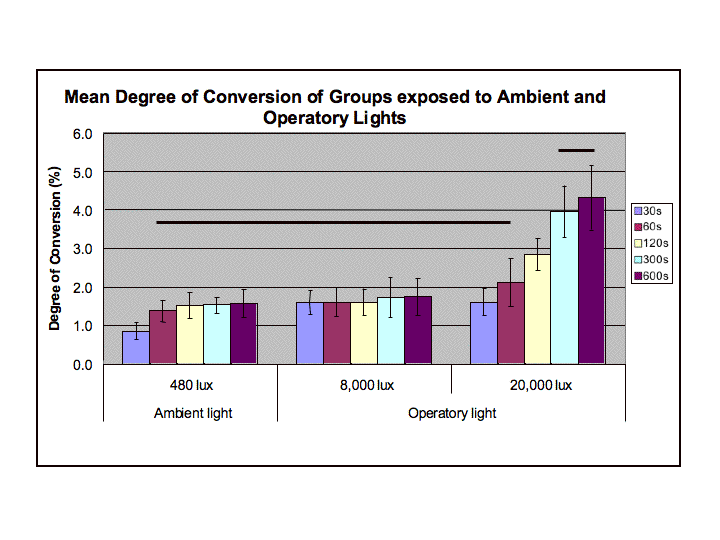ABSTRACT: 1116
Effect of Operatory Light Settings on Polymerization Of Orthodontic Resin
| A.N. MULLASSERIL1, S.S. KHAJOTIA1, G. LOLLI2, and G.F. CURRIER1, 1University of Oklahoma Health Sciences Center, Oklahoma City, USA, 2University of Oklahoma, Norman, USA |
Objectives: Dental operatory lights are available with a choice of intensity settings. The aim of this study was to compare the effect of specific durations of exposure to 8,000lux and widely-used 20,000lux settings of an operatory light and of ambient light on the degree of conversion (DC) of a light-cured orthodontic resin. DC values of the resin after light-activation with conventional halogen (Optilux 500) or high-intensity LED (Ortholux LED) light-curing units were also compared. Methods: Specimens of uncured Transbond-XT orthodontic resin (3M-Unitek; n=200) were mixed with KBr powder (1:9 ratio) to form pellets that were covered with stainless-steel brackets and exposed to the 8,000lux or 20,000lux settings of the A-dec 571 dental operatory light or to ambient light (480lux) for 30s, 1min, 2min, 5min, or 10min, or to one of the light-curing units for 10s or 20s (n=10/group). DC (%) values were calculated from FTIR spectroscopy measurements in transmission mode. DC values were compared using General-Linear-Models and post hoc Duncan’s multiple range tests, and the relationships with exposure time were modeled using Linear regression analyses (α=0.05). Results: Exposures of 120s or longer to the 20,000lux setting and of 30s to ambient light were statistically different from the remaining intensities and exposure times (p<0.0001). It was also found that the mean DC values at 10s and 20s for the LED light (29.8%, 30.3%) were higher (p=0.0002) than for the halogen light (15.3%, 22.7%). Conclusions: DC (%) of the orthodontic resin was strongly affected by time of exposure and intensity of the operatory light such that exposures of 120s or greater resulted in DC values significantly higher than all other exposure-intensity combinations. The least DC value was that for ambient light at 30s. The LED light resulted in higher mean DC values than the halogen light at both exposure times. |
| Seq #162 - Miscellaneous Topics 10:45 AM-12:00 PM, Saturday, April 5, 2008 Hilton Anatole Hotel Trinity I - Exhibit Hall |
|
Back to the Dental Materials 8: Other Matierals - Chemistry, Properties and Performance Program |
©Copyright 2008 American Association for Dental Research. All Rights Reserved.
